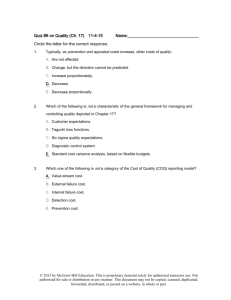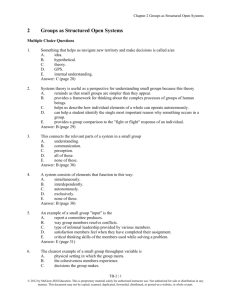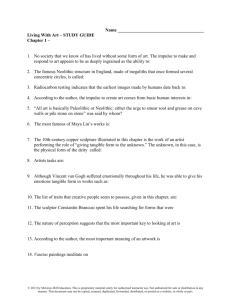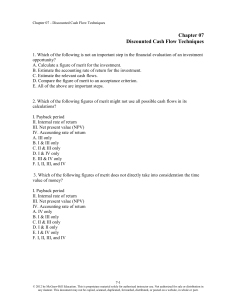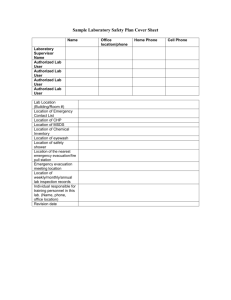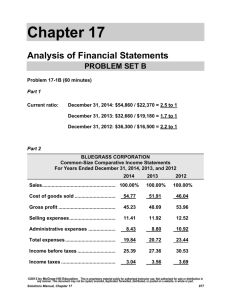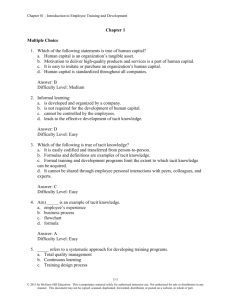TBChap002-5e-MS
advertisement
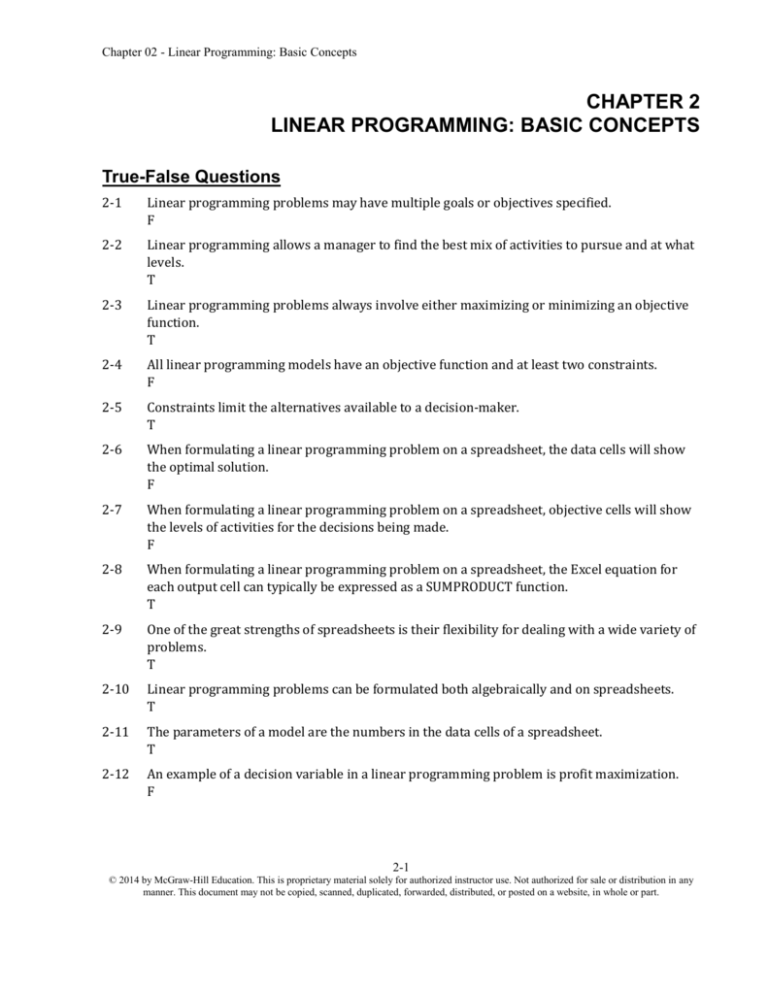
Chapter 02 - Linear Programming: Basic Concepts CHAPTER 2 LINEAR PROGRAMMING: BASIC CONCEPTS True-False Questions 2-1 Linear programming problems may have multiple goals or objectives specified. F 2-2 Linear programming allows a manager to find the best mix of activities to pursue and at what levels. T 2-3 Linear programming problems always involve either maximizing or minimizing an objective function. T 2-4 All linear programming models have an objective function and at least two constraints. F 2-5 Constraints limit the alternatives available to a decision-maker. T 2-6 When formulating a linear programming problem on a spreadsheet, the data cells will show the optimal solution. F 2-7 When formulating a linear programming problem on a spreadsheet, objective cells will show the levels of activities for the decisions being made. F 2-8 When formulating a linear programming problem on a spreadsheet, the Excel equation for each output cell can typically be expressed as a SUMPRODUCT function. T 2-9 One of the great strengths of spreadsheets is their flexibility for dealing with a wide variety of problems. T 2-10 Linear programming problems can be formulated both algebraically and on spreadsheets. T 2-11 The parameters of a model are the numbers in the data cells of a spreadsheet. T 2-12 An example of a decision variable in a linear programming problem is profit maximization. F 2-1 © 2014 by McGraw-Hill Education. This is proprietary material solely for authorized instructor use. Not authorized for sale or distribution in any manner. This document may not be copied, scanned, duplicated, forwarded, distributed, or posted on a website, in whole or part. Chapter 02 - Linear Programming: Basic Concepts 2-13 A feasible solution is one that satisfies all the constraints of a linear programming problem simultaneously. T 2-14 An infeasible solution violates all of the constraints of the problem. F 2-15 The best feasible solution is called the optimal solution. T 2-16 Since all linear programming models must contain nonnegativity constraints, Solver will automatically include them and it is not necessary to add them to a formulation. F 2-17 The line forming the boundary of what is permitted by a constraint is referred to as a parameter. F 2-18 The origin satisfies any constraint with a ≥ sign and a positive right-hand side. F 2-19 The feasible region only contains points that satisfy all constraints. T 2-20 A circle would be an example of a feasible region for a linear programming problem. F 2-21 The equation 5x + 7y = 10 is linear. T 2-22 The equation 3xy = 9 is linear. F 2-23 The graphical method can handle problems that involve any number of decision variables. F 2-24 An objective function represents a family of parallel lines. T 2-25 When solving linear programming problems graphically, there are an infinite number of possible objective function lines. T 2-26 For a graph where the horizontal axis represents the variable x and the vertical axis represents the variable y, the slope of a line is the change in y when x is increased by 1. T 2-2 © 2014 by McGraw-Hill Education. This is proprietary material solely for authorized instructor use. Not authorized for sale or distribution in any manner. This document may not be copied, scanned, duplicated, forwarded, distributed, or posted on a website, in whole or part. Chapter 02 - Linear Programming: Basic Concepts 2-27 The value of the objective function decreases as the objective function line is moved away from the origin. F 2-28 A feasible point on the optimal objective function line is an optimal solution. T 2-29 A linear programming problem can have multiple optimal solutions. T 2-30 All constraints in a linear programming problem are either ≤ or ≥ inequalities. F 2-31 Linear programming models can have either ≤ or ≥ inequality constraints but not both in the same problem. F 2-32 A maximization problem can generally be characterized by having all ≥ constraints. F 2-33 If a single optimal solution exists while using the graphical method to solve a linear programming problem, it will exist at a corner point. T 2-34 When solving a maximization problem graphically, it is generally the goal to move the objective function line out, away from the origin, as far as possible. T 2-35 When solving a minimization problem graphically, it is generally the goal to move the objective function line out, away from the origin, as far as possible. F 2-3 © 2014 by McGraw-Hill Education. This is proprietary material solely for authorized instructor use. Not authorized for sale or distribution in any manner. This document may not be copied, scanned, duplicated, forwarded, distributed, or posted on a website, in whole or part. Chapter 02 - Linear Programming: Basic Concepts Multiple-Choice Questions 2-36 A manager should know the following things about linear programming. a. What it is. b. When it should be used. c. When it should not be used. d. How to interpret the results of a study. *e. All of the above. 2-37 Which of the following is not a component of a linear programming model? a. Constraints. b. Decision variables. c. Parameters. d. An objective. *e. A spreadsheet. 2-38 In linear programming, solutions that satisfy all of the constraints simultaneously are referred to as: a. optimal. *b. feasible. c. nonnegative. d. targeted. e. All of the above. 2-39 When formulating a linear programming problem on a spreadsheet, which of the following is true? a. Parameters are called data cells. b. Decision variables are called changing cells. c. Nonnegativity constraints must be included. d. The objective function is called the objective cell. *e. All of the above. 2-4 © 2014 by McGraw-Hill Education. This is proprietary material solely for authorized instructor use. Not authorized for sale or distribution in any manner. This document may not be copied, scanned, duplicated, forwarded, distributed, or posted on a website, in whole or part. Chapter 02 - Linear Programming: Basic Concepts Questions 2-40 through 2-43 refer to the following spreadsheet. A 1 2 3 4 5 6 7 8 9 10 Unit Cost Benefit A B C Solution B Activity 1 $15 C Activity 2 $20 Contribution per Unit 1 2 2 3 1 1 Activity 1 2 2-40 Where are the data cells located? a. B2:C2. *b. B2:C2, B5:C7, and F5:F7. c. B10:C10. d. F10. e. None of the above. 2-41 Where are the changing cells located? a. B2:C2. b. B2:C2, B5:C7, and F5:F7. *c. B10:C10. d. F10. e. None of the above. 2-42 Where is the objective cell located? a. B2:C2. b. B2:C2, B5:C7, and F5:F7. c. B10:C10. *d. F10. e. None of the above. 2-43 Where are the output cells located? a. B2:C2. b. B2:C2, B5:C7, and F5:F7. c. B10:C10. d. F10. *e. None of the above. Activity 2 4 D E F Totals 10 16 6 >= >= >= Needed 10 6 6 Total Cost $110 2-5 © 2014 by McGraw-Hill Education. This is proprietary material solely for authorized instructor use. Not authorized for sale or distribution in any manner. This document may not be copied, scanned, duplicated, forwarded, distributed, or posted on a website, in whole or part. Chapter 02 - Linear Programming: Basic Concepts 2-44 Which of the following could not be a constraint for a linear programming problem? a. 1A + 2B ≤ 3. b. 1A + 2B ≥ 3. c. 1A + 2B = 3. *d. 1A + 2B. e. 1A + 2B + 3C ≤ 3. 2-45 For the products A, B, C, and D, which of the following could be a linear programming objective function? *a. P = 1A + 2B +3C + 4D. b. P = 1A + 2BC +3D. c. P = 1A + 2AB +3ABC + 4ABCD. d. P = 1A + 2B/C +3D. e. All of the above. 2-46 After the data is collected the next step to formulating a linear programming model is to: *a. identify the decision variables. b. identify the objective function. c. identify the constraints. d. specify the parameters of the problem. e. None of the above. 2-47 When using the graphical method, the region that satisfies all of the constraints of a linear programming problem is called the: a. optimum solution space. b. region of optimality. c. profit maximization space. *d. feasible region. e. region of nonnegativity. 2-48 Solving linear programming problems graphically, a. is possible with any number of decision variables. *b. provides geometric intuition about what linear programming is trying to achieve. c. will always result in an optimal solution. d. All of the above. e. None of the above. 2-6 © 2014 by McGraw-Hill Education. This is proprietary material solely for authorized instructor use. Not authorized for sale or distribution in any manner. This document may not be copied, scanned, duplicated, forwarded, distributed, or posted on a website, in whole or part. Chapter 02 - Linear Programming: Basic Concepts 2-49 Which objective function has the same slope as this one: 4x + 2y = 20. a. 2x +4y = 20. b. 2x – 4y = 20. c. 4x – 2y = 20. d. 8x + 8y = 20. *e. 4x + 2y = 10. 2-50 Given the following 2 constraints, which solution is a feasible solution for a maximization problem? (1) 14x1 + 6x2 ≤ 42 (2) x1 – x2 ≤ 3 a. b. c. *d. e. 2-51 Which of the following constitutes a simultaneous solution to the following 2 equations? (1) 3x1 + 4x2 = 10 (2) 5x1 + 4x2 = 14 a. b. *c. d. e. 2-52 (x1, x2 ) = (1,5). (x1, x2 ) = (5,1). (x1, x2 ) = (4,4). (x1, x2 ) = (2,1). (x1, x2 ) = (2,6). (x1, x2 ) = (2, 0.5). (x1, x2 ) = (4, 0.5). (x1, x2 ) = (2, 1). x1 = x2 . x2 = 2x1.. Which of the following constitutes a simultaneous solution to the following 2 equations? (1) 3x1 + 2x2 = 6 (2) 6x1 + 3x2 = 12 a. b. c. *d. e. (x1, x2 ) = (1,1.5). (x1, x2 ) = (0.5, 2). (x1, x2 ) = (0,3). (x1, x2 ) = (2,0). (x1, x2 ) = (0,0). 2-7 © 2014 by McGraw-Hill Education. This is proprietary material solely for authorized instructor use. Not authorized for sale or distribution in any manner. This document may not be copied, scanned, duplicated, forwarded, distributed, or posted on a website, in whole or part. Chapter 02 - Linear Programming: Basic Concepts 2-53 What is the optimal solution for the following problem? Maximize P = 3x + 15 y subject to 2x + 4y ≤ 12 5x + 2y ≤ 10 and x ≥ 0, y ≥ 0. a. *b. c. d. e. 2-54 Given the following 2 constraints, which solution is a feasible solution for a minimization problem? (1) 14x1 + 6x2 ≥ 42 (2) x1 + 3x2 ≥ 6 a. b. *c. d. e. 2-55 (x, y) = (2, 0). (x, y) = (0, 3). (x, y) = (0, 0). (x, y) = (1, 5). None of the above. (x1 , x2 ) = (0.5, 5). (x1 , x2 ) = (0, 4). (x1 , x2 ) = (2, 5). (x1 , x2 ) = (1, 2). (x1 , x2 ) = (2, 1). What is the optimal solution for the following problem? Minimize C = 3x + 15y subject to 2x + 4y ≥ 12 5x + 2y ≥ 10 and x ≥ 0, y ≥ 0. a. b. c. d. *e. (x, y) = (0, 0). (x, y) = (0, 3). (x, y) = (0, 5). (x, y) = (1, 2.5). (x, y) = (6, 0). 2-8 © 2014 by McGraw-Hill Education. This is proprietary material solely for authorized instructor use. Not authorized for sale or distribution in any manner. This document may not be copied, scanned, duplicated, forwarded, distributed, or posted on a website, in whole or part. Chapter 02 - Linear Programming: Basic Concepts Questions 2-56 through 2-60 refer to the following: The production planner for Fine Coffees, Inc. produces two coffee blends: American (A) and British (B). He can only get 300 pounds of Colombian beans per week and 200 pounds of Dominican beans per week. Each pound of American blend coffee requires 12 ounces of Colombian beans and 4 ounces of Dominican beans, while a pound of British blend coffee uses 8 ounces of each type of bean. Profits for the American blend are $2.00 per pound, and profits for the British blend are $1.00 per pound. 2-56 What is the objective function? a. P = A + 2B. b. P = 12A + 8B. *c. P = 2A + B. d. P = 8A + 12B. e. P = 4A + 8B. 2-57 What is the constraint for Colombian beans? a. A + 2B ≤ 4,800. *b. 12A + 8B ≤ 4,800. c. 2A + B ≤ 4,800. d. 8A + 12B ≤ 4,800. e. 4A + 8B ≤ 4,800. 2-58 What is the constraint for Dominican beans? a. 12A + 8B ≤ 4,800. b. 8A + 12B ≤ 4,800. *c. 4A + 8B ≤ 3,200. d. 8A + 4B ≤ 3,200. e. 4A + 8B ≤ 4,800. 2-59 Which of the following is not a feasible solution? a. (A, B) = (0, 0). b. (A, B) = (0, 400). c. (A, B) = (200, 300). d. (A, B) = (400, 0). *e. (A, B) = (400, 400). 2-9 © 2014 by McGraw-Hill Education. This is proprietary material solely for authorized instructor use. Not authorized for sale or distribution in any manner. This document may not be copied, scanned, duplicated, forwarded, distributed, or posted on a website, in whole or part. Chapter 02 - Linear Programming: Basic Concepts 2-60 What is the weekly profit when producing the optimal amounts? a. $0. b. $400. *c. $700. d. $800. e. $900. Questions 2-61 through 2-64 refer to the following: The operations manager for the Blue Moon Brewing Co. produces two beers: Lite (L) and Dark (D). He can only get 675 gallons of malt extract per day for brewing and his brewing hours are limited to 8 hours per day. To produce a keg of Lite beer requires 2 minutes of time and 5 gallons of malt extract. Each keg of Dark beer needs 4 minutes of time and 3 gallons of malt extract. Profits for Lite beer are $3.00 per keg and profits for Dark beer are $2.00 per keg. 2-61 What is the objective function? a. P = 2L + 3D. b. P = 2L + 4D. *c. P = 3L + 2D. d. P = 4L + 2D. e. P = 5L + 3D. 2-62 What is the time constraint? a. 2L +3D ≤ 480. *b. 2L + 4D ≤ 480. c. 3L + 2D ≤ 480. d. 4L + 2D ≤ 480. e. 5L + 3D ≤ 480. 2-63 Which of the following is not a feasible solution? a. (L, D) = (0, 0). b. (L, D) = (0, 120). c. (L, D) = (90, 75). d. (L, D) = (135, 0). *e. (L, D) = (135, 120). 2-10 © 2014 by McGraw-Hill Education. This is proprietary material solely for authorized instructor use. Not authorized for sale or distribution in any manner. This document may not be copied, scanned, duplicated, forwarded, distributed, or posted on a website, in whole or part. Chapter 02 - Linear Programming: Basic Concepts 2-64 What is the daily profit when producing the optimal amounts? a. $0. b. $240. *c. $420. d. $405. e. $505. Questions 2-65 through 2-68 refer to the following: The production planner for a private label soft drink maker is planning the production of two soft drinks: root beer (R) and sassafras soda (S). There are at most 12 hours per day of production time and 1500 gallons per day of carbonated water available. A case of root beer requires 2 minutes of time and 5 gallons of water to produce, while a case of sassafras soda requires 3 minutes of time and 5 gallons of water. Profits for the root beer are $6.00 per case, and profits for the sassafras soda are $4.00 per case. 2-65 What is the objective function? a. P = 4R + 6S. b. P = 2R + 3S. *c. P = 6R + 4S. d. P = 3R +2S. e. P = 5R + 5S. 2-66 What is the time constraint? *a. 2R +3S ≤ 720. b. 2R + 5S ≤ 720. c. 3R + 2S ≤ 720. d. 3R + 5S ≤ 720. e. 5R + 5S ≤ 720. 2-67 Which of the following is not a feasible solution? a. (R, S) = (0, 0). b. (R, S) = (0, 240). c. (R, S) = (180, 120). d. (R, S) = (300, 0). *e. (R, S) = (180, 240). 2-11 © 2014 by McGraw-Hill Education. This is proprietary material solely for authorized instructor use. Not authorized for sale or distribution in any manner. This document may not be copied, scanned, duplicated, forwarded, distributed, or posted on a website, in whole or part. Chapter 02 - Linear Programming: Basic Concepts 2-68 What is the daily profit when producing the optimal amounts? a. $960. *b. $1,560. c. $1,800. d. $1,900. e. $2,520. Questions 2-69 through 2-72 refer to the following: An electronics firm produces two models of pocket calculators: the A-100 (A) and the B-200 (B). Each model uses one circuit board, of which there are only 2,500 available for this week’s production. In addition, the company has allocated a maximum of 800 hours of assembly time this week for producing these calculators. Each A-100 requires 15 minutes to produce while each B-200 requires 30 minutes to produce. The firm forecasts that it could sell a maximum of 4,000 of the A-100s this week and a maximum of 1,000 B-200s. Profits for the A100 are $1.00 each and profits for the B-200 are $4.00 each. 2-69 What is the objective function? a. P = 4A + 1B. b. P = 0.25A +1B. *c. P = 1A + 4B. d. P = 1A + 1B. e. P = 0.25A + 0.5B. 2-70 What is the time constraint? a. 1A + 1B ≤ 800. *b. 0.25A + 0.5B ≤ 800. c. 0.5A + 0.25B ≤ 800. d. 1A + 0.5B ≤ 800. e. 0.25A + 1B ≤ 800. 2-12 © 2014 by McGraw-Hill Education. This is proprietary material solely for authorized instructor use. Not authorized for sale or distribution in any manner. This document may not be copied, scanned, duplicated, forwarded, distributed, or posted on a website, in whole or part. Chapter 02 - Linear Programming: Basic Concepts 2-71 Which of the following is not a feasible solution? a. (A, B) = (0, 0). b. (A, B) = (0, 1000). c. (A, B) = (1800, 700). d. (A, B) = (2500, 0). *e. (A, B) = (100, 1600). 2-72 What is the weekly profit when producing the optimal amounts? *a. $10,000. b. $4,600. c. $2,500. d. $5,200. e. $6,400. Questions 2-73 through 2-76 refer to the following: A local bagel shop produces bagels (B) and croissants (C). Each bagel requires 6 ounces of flour, 1 gram of yeast, and 2 tablespoons of sugar. A croissant requires 3 ounces of flour, 1 gram of yeast, and 4 tablespoons of sugar. The company has 6,600 ounces of flour, 1,400 grams of yeast, and 4,800 tablespoons of sugar available for today’s baking. Bagel profits are 20 cents each and croissant profits are 30 cents each. 2-73 What is the objective function? a. P = 0.3B + 0.2C. b. P =0.6B + 0.3C. *c. P = 0.2B + 0.3C. d. P = 0.2B + 0.4C. e. P =0.1B + 0.1C. 2-74 What is the sugar constraint? a. 6B + 3C ≤ 4,800. b. 1B + 1C ≤ 4,800. *c. 2B + 4C ≤ 4,800. d. 4B + 2C ≤ 4,800. e. 2B + 3C ≤ 4,800. 2-13 © 2014 by McGraw-Hill Education. This is proprietary material solely for authorized instructor use. Not authorized for sale or distribution in any manner. This document may not be copied, scanned, duplicated, forwarded, distributed, or posted on a website, in whole or part. Chapter 02 - Linear Programming: Basic Concepts 2-75 Which of the following is not a feasible solution? a. (B, C) = (0, 0). b. (B, C) = (0, 1100). c. (B, C) = (800, 600). d. (B, C) = (1100, 0). *e. (B, C) = (0, 1400). 2-76 What is the daily profit when producing the optimal amounts? a. $580. *b. $340. c. $220. d. $380. e. $420. Questions 2-77 through 2-80 refer to the following: The owner of Crackers, Inc. produces both Deluxe (D) and Classic (C) crackers. She only has 4,800 ounces of sugar, 9,600 ounces of flour, and 2,000 ounces of salt for her next production run. A box of Deluxe crackers requires 2 ounces of sugar, 6 ounces of flour, and 1 ounce of salt to produce. A box of Classic crackers requires 3 ounces of sugar, 8 ounces of flour, and 2 ounces of salt to produce. Profits are 40 cents for a box of Deluxe crackers and 50 cents for a box of Classic crackers. 2-77 What is the objective function? a. P = 0.5D + 0.4C. b. P =0.2D + 0.3C. *c. P = 0.4D + 0.5C. d. P = 0.1D + 0.2C. e. P =0.6D + 0.8C. 2-78 What is the sugar constraint? *a. 2D + 3C ≤ 4,800. b. 6D + 8C ≤ 4,800. c. 1D + 2C ≤ 4,800. d. 3D + 2C ≤ 4,800. e. 4D + 5C ≤ 4,800. 2-79 Which of the following is not a feasible solution? a. (D, C) = (0, 0). b. (D, C) = (0, 1000). c. (D, C) = (800, 600). d. (D, C) = (1600, 0). *e. (D, C) = (0, 1,200). 2-14 © 2014 by McGraw-Hill Education. This is proprietary material solely for authorized instructor use. Not authorized for sale or distribution in any manner. This document may not be copied, scanned, duplicated, forwarded, distributed, or posted on a website, in whole or part. Chapter 02 - Linear Programming: Basic Concepts 2-80 What is the daily profit when producing the optimal amounts? a. $800. b. $500. *c. $640. d. $620. e. $600. Questions 2-81 through 2-84 refer to the following: The operations manager of a mail order house purchases double (D) and twin (T) beds for resale. Each double bed costs $500 and requires 100 cubic feet of storage space. Each twin bed costs $300 and requires 90 cubic feet of storage space. The manager has $75,000 to invest in beds this week, and her warehouse has 18,000 cubic feet available for storage. Profit for each double bed is $300 and for each twin bed is $150. 2-81 What is the objective function? a. P = 150D + 300T. b. P = 500D + 300T. c. P = 300D + 500T. *d. P = 300D + 150T. e. P = 100D + 90T. 2-82 What is the storage space constraint? a. 100D + 90T ≤ 18,000. b. 100D + 90T ≥ 18,000. c. 300D + 90T ≤ 18,000. d. 500D + 100T ≤ 18,000. *e. 100D + 90T ≤ 18,000. 2-83 Which of the following is not a feasible solution? a. (D, T) = (0, 0). *b. (D, T) = (0, 250). c. (D, T) = (150, 0). d. (D, T) = (90, 100). e. (D, T) = (0, 200). 2-84 What is the weekly profit when ordering the optimal amounts? a. $0. b. $30,000. c. $42,000. *d. $45,000. e. $54,000. 2-15 © 2014 by McGraw-Hill Education. This is proprietary material solely for authorized instructor use. Not authorized for sale or distribution in any manner. This document may not be copied, scanned, duplicated, forwarded, distributed, or posted on a website, in whole or part.
